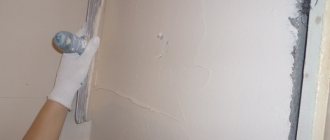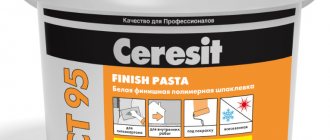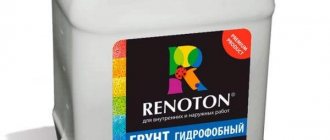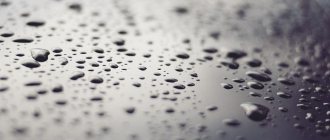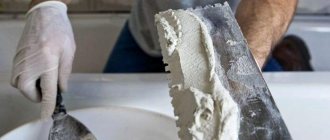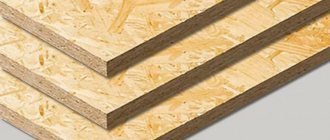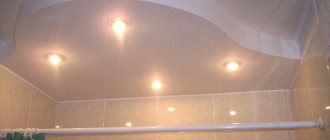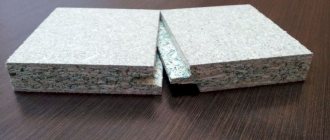The construction market has been offering cement-based putty as a coating for interior work for decades. It has proven itself to be a fairly strong, reliable and (you must agree, this is essential) durable coating. It is used for finishing the surface layer in any buildings, even in objects with excess moisture. It perfectly eliminates cracks, hides unevenness and many other surface irregularities.
Attention!!! It is important! The putty is very versatile. It interacts well with various types of surface bases: concrete, foam concrete, wood, cement.
Classification depending on the color of cement in the building mixture
The composition of cement putty, as the main active component, includes, of course, cement, as well as polymer additives and various types of mineral fillers. It is this composition that guarantees and makes it possible to create an ideal, smooth surface that does not require further processing. In addition, quartz sand has been added to the composition, which has a granular structure, which plays a decisive role in the intended purpose of the putty.
Types of putty
Putty (base – cement) for finishing walls and ceilings, depending on its components and scope of work, is divided into two large groups:
- Starting. The most important advantage of this type is the elimination of significant surface errors. As a rule, it is used in the initial stages of work to level the surface. The thickness of the applied layer is approximately 1.5-2 cm. This is facilitated by large particles of quartz sand (0.5-0.8 mm). For the final (finishing) layer, this type of putty is not appropriate (the large size of the quartz sand fractions), although the resulting layer is quite even.
- Finish. It is used at the final stages of work to give the surface a perfectly smooth state. The composition also contains quartz sand, but finer (0.2 mm). This type of putty is not able to hide fairly large cracks or irregularities.
Specifications
With the base mixture it is easy to prepare the base for further work.
Basic construction putties have excellent adhesion (adhesion coefficient) to any mineral surface and are intended for application in a layer of 5 to 10 mm. With their help, you can prepare a load-bearing base for any further finishing, seal gaps and cracks on the wall surface, etc.
Dry mixtures consist of a filler, which is quartz sand of various fractions (from 0.1 to 0.5 mm), a binder component (gypsum or cement) and polymer additives.
Additives are designed to improve the quality of the finished solution - they increase plasticity and adhesion, increase durability, and make it resistant to aggressive environmental influences. The technical characteristics of the putty and the permissible area of its application largely depend on the use of certain additives and their percentage in the total mass of the composition. For an overview of basic plasters, watch this video:
The main requirements for basic putty compositions:
- when dry, they should form a flat, maximally smooth surface;
- have excellent adhesion to the surface being treated;
- be sufficiently flexible and easy to level over the entire base area.
Below are approximate technical characteristics that basic putty compounds must meet.
| № | Consumption at a layer thickness of 1 mm, per 1 sq.m | 0.9 - 1 kg |
| 1 | Thickness of the solution layer, mm | Thickness of the solution layer, mm 0.5 - 8 |
| 2 | Viability of solution | 2 - 2.5 hours |
| 3 | Temperature of work and substrate | from +5 °С to +30 °С |
| 4 | Compressive strength | 10 MPa |
| 5 | Adhesion strength | 0.6 MPa |
Release form
The following division into types depends on the form of release:
- Dry. You can control the level of consistency, but it is very important to properly dilute the solution itself and then apply it to the surface without errors. Adheses very well to the base.
- Pasty. Available in plastic containers. The cost, of course, is higher for a similar, but dry mixture. Also, the builder is deprived of the ability to independently regulate the consistency of the mixture.
The color of the cement in the composition determines its category:
- gray mixture;
- white cement putty;
- super white composition.
Gray
Dry finishing gray putty contains cement, some mineral fillers and all sorts of functional additives. The mixture is quite moisture-resistant and plastic, very easy to apply and spread over the surface without much effort, and has very good adhesion to the application base.
It is used for rough leveling of the surface layer of ceilings and walls made of concrete or brick. Gray putty has proven itself well when carrying out interior (exterior) work on surfaces that are regularly exposed to moisture or temperature changes.
Cement white
White cement putty has good adhesion (the ability to firmly adhere to the applied surface material) to any mineral base and is weather-resistant. White putty is used to smooth out roughness, fill irregularities and cracks on concrete, cement and even lime-cement surfaces. Very easy to sand and paint. The maximum thickness of the applied layer can reach 30 mm.
Super white composition
The composition includes white cement, necessarily quartz sand, polymers and some pigments (ground marble), due to which the finished surface acquires a perfectly white, snowy color. When dissolved with water, a very plastic mixture is obtained, which, after hardening, forms a fairly strong frost-resistant and moisture-resistant layer. Can be applied to cement, concrete, reinforced concrete and cement-lime surfaces. Professionals recommend using this material only if you are finishing the room with bull paint. Why? The answer is obvious. This type of putty has a high price and this is its main drawback.
Review of popular cement-based putties
Plitonit K
Available in two versions - white and grey. It is intended for finishing surfaces inside the house and outside. The layer of this type of finishing material should not exceed 5 millimeters. You can work with the material at temperatures from 20 degrees below zero to 70 degrees above zero.
The temperature after application should be from 5 to 30 degrees above zero for at least 3 days. If the material was used to finish the building on the street side, then the surface must be protected from precipitation.
Putty Plitonit K.
Kreps VL
Available in three versions - grey, white and super white. It contains microcalcite - ground marble with special additives, which ensure a particularly durable and moisture- and frost-resistant surface.
Putty is a finishing mixture for finishing houses inside and outside. The maximum layer thickness reaches 3 millimeters. After applying the solution, it is necessary to provide the surface with protection from temperature changes, drafts and direct sunlight.
Putty Kreps VL super white.
Founds Belsilk T-32
White cement putty is intended for interior and exterior work. Excellent for leveling surfaces with small differences in levels and other defects.
Expensive putty mixture Found Belsilk T-32.
Advantages and disadvantages
Cement itself is a fairly strong, durable and reliable material, so building mixtures on this basis also have these qualities. The addition of a certain amount of modifying additives significantly increases the strength of dry putties.
Attention!!! It is important! Cement-based putties have excellent water resistance, so they are perfect for rooms with high humidity (bathroom, basement, kitchen, etc.). All types of putty (gray, white and super white) can easily withstand humidity levels of almost 96%.
The use of cement putty is often practiced not only for interior work, but also for facade finishing, as they flawlessly withstand any weather changes (snow, rain, ultraviolet radiation, frost). Also, do not forget that the material itself is an environmentally friendly substance, since it contains only natural and absolutely harmless ingredients. One of the advantages is the ability to create a perfectly smooth, extremely thin surface (1 mm and above). The advantage of this composition is the absence of shrinkage and cracking over time.
Among the disadvantages, it should be noted that cement-based putty interacts very poorly with various paints and varnishes. In other words, you should not mix cement putty with various varnishes, adhesives or paints, which can significantly change the performance properties of the original mixture.
You should also know that the entry of any foreign particles into the solution makes the prepared mass completely unsuitable for further use.
Features of working with moisture-resistant putty
Any putty for bathrooms, pools and other wet areas gains hardness within 24 hours after application. High-quality compounds have increased elasticity. They cover the surface with an even layer and have good adhesion to the main surface. Knauf plaster with a moisture-resistant effect makes it possible to well protect the base and install finishing with high decorative qualities.
Cement-based mixtures such as Vetonit contain plasticizing components and pigment dyes. The result is an optimal putty for a bathroom to be painted.
Some compositions can be used in facade work. But they can also be used to treat interior surfaces. Vetonit putty mixture, intended for facade work, is suitable for use on walls in damp rooms. This is a great solution if you have some mixture left after working on the outside surface of the walls. But you can also purchase a special composition for rooms with high humidity.
A feature of most modern mixtures is that there is no need to purchase special tools. The compositions are used on a primer layer, which can be applied manually. After this, leveling is carried out, repairing all irregularities and minor defects.
Advice! On critical areas of the surface it is necessary to apply another layer of a mixture with a moisture-resistant composition. This is important if you are using putty under tiles.
Type of work performed
The entire range of cement-based putty can also be divided according to the type of work performed:
- decorative;
- thermal insulation.
Decorative
The basis of this type of plasters is gray cement with the addition of colored ground clinker. When applying this type of putty, the texture and color of the main coating in most cases is determined by the finishing layer, which is explained by the rather high price of colored cement, in contrast to the classic gray color.
To add color effects and decorative texture, colored sand, lime or crushed rock particles are added to the mixture.
Thermal insulation
It is used for leveling and thermal insulation of building surfaces made of brick, concrete, aerated block masonry, ordinary cement or gypsum plasters. The composition contains special additives and lightweight filler (foam balls), which, having poor thermal conductivity, perfectly retains heat in the interior. Shelf life is approximately 3.5 years.
Finishing technology
How to work with moisture-resistant putty? Exactly the same as with a regular one, and it doesn’t matter what it’s made from: gypsum, cement or latex. You should not immediately dilute the putty powder, as indicated in the instructions; before using it, you need to carry out several preparatory steps:
- Clean the wall. Traces of old finishing, dust and various contaminants are removed from the surface. For this, depending on the degree of contamination, a spatula or a metal brush is used. Some craftsmen prefer to use a sander with an appropriate attachment.
- Wash. Some craftsmen neglect this stage, especially when carrying out facade finishing, but washing more completely removes all contaminants. To wash facades or fences, it is recommended to use a portable car wash, and wash the walls in rooms with a brush and rag. It is very important to thoroughly rinse the detergents used with clean water, otherwise the soap components may impair adhesion when applying primer and puttying.
- Dry. Drying is not necessary only when using cement putty.
- Prime. Applying primer will increase adhesion during puttying and make the connection stronger and more durable.
After the soil has dried, the base is ready, now you can dilute the putty powder as indicated in the instructions. It is necessary to dilute in small quantities, since the mixture thickens quickly.
You need to putty the wall in a thin layer, applying the composition with a rubber spatula and evenly distributing it over the surface. If the cracks or dents are large, then there is no need to try to repair them immediately - it is better to wait for the applied solution to dry, prime it again and repeat the leveling. The number of layers of putty applied when leveling is not limited. It is only important to apply each subsequent layer after the previous one has dried and do not forget to use a primer.
It is a mistake to believe that the use of moisture-resistant putty mixtures is an unnecessary waste of money and that you can get by with conventional compounds. After a couple of years in the kitchen or bathroom (on the facade this will happen within a year), the decorative finish will become deformed and lose its attractive appearance. It will need to be replaced. It is worth calculating the cost of moisture-resistant putty and the costs of premature repairs and concluding that it is more profitable to purchase.
Formation of pricing policy depending on color
Color plays a decisive role in shaping the pricing strategy. The price of the compositions is quite high, so not all hardware stores can afford such a product.
Dry putty is sold in paper bags of 5-20(25) kg. If such large volumes of the mixture are not required, then you can always purchase putty pastes that are packaged in buckets.
Cost per sq. meter depends directly on the consumption of material, which is determined by the thickness of the application.
Attention!!! It is important! Remember that a square meter of plaster applied using the simplest technique costs much less than in an artistic style.
Colored putty
Very often, colored putty is understood as any decorative plaster. First of all, this is any type of decorative coating, although there is still some division into groups:
- Available ready-made and only in a certain color. For example, the color of mosaic plaster is determined by the presence and color of its granules, since the color pigment must match the shade of the stone component;
- the next group is produced in the form of a white or gray mass, which is then tinted. These are, as a rule, textured polymer-based plasters. Different amounts of added pigment make it possible to obtain a solution of various colors.
Recommendations for selection
When purchasing, pay attention to the brand of cement and quartz sand in the composition. The granularity of the coating depends on the size of the particles, and a poor-quality cement composition will result in cracking of the surface layer with its subsequent crumbling.
Gray is better suited for rough leveling the surface, but for finishing work the ideal option is white or super white putty.
Experts recommend dry mixtures in bags, as they can provide 100% strength to the applied base. But it is not advisable to use ready-made mixtures.
Properties
Puttying of walls in the bathroom and other wet rooms is carried out before subsequent painting or finishing the surface with ceramic tiles. Regardless of the decorative layer, the putty should have the following properties:
- high resistance to moisture, which preserves the putty even after decades;
- resistance to temperature changes that are typical for the bathroom and kitchen;
- environmental friendliness, since the mixture must be safe for human health;
- affordable cost, which is important when applied to a large area.
As a result, you should have a durable and strong layer that is ideal for the ceiling and walls in the bathroom. It should interact well with the tiles and the coloring composition. If you plan to apply bright or dark paint, you can go with a cement mixture. If you are looking for a composition for walls to paint, pay attention to the Vetonit polymer mixture.
These properties are basic. In a specific situation, it is necessary to be guided by the most important qualities for the room.
One of the most versatile is Knauf plaster, which allows you to create any design solutions even in the wettest rooms.
